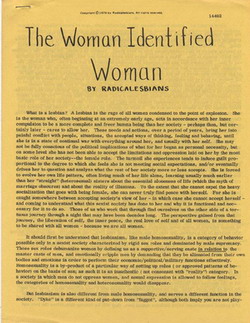The Woman-Identified Woman facts for kids
"The Woman-Identified Woman" was a short but powerful document. It was written in 1970 by a group called the Radicalesbians. This group was made up of lesbian radical feminists.
The document was first shared on May 1, 1970. This happened during a protest known as the Lavender Menace at the Second Congress to Unite Women in New York City. Today, many people see it as a very important paper. It helped shape both radical feminism and lesbian feminism.
The main writers were Artemis March, Lois Hart, Rita Mae Brown, Ellen Shumsky, Cynthia Funk, and Barbara XX. Artemis March also edited it. At the Congress, these women took over the stage. They turned off the lights and used the microphone. They were upset because lesbian speakers were not allowed to talk. They handed out copies of their paper, "The Woman-Identified Woman." They said that lesbians were leading the way for women's freedom. This was because lesbians focused on other women, not on men. The paper said that women connecting with other women was key to women's liberation. It was also the start of a new way of thinking. Later, in September 1971, the NOW group agreed. They said that lesbian rights were important for feminism.
Contents
Why This Document Was Important
This paper was very critical of how some feminist groups were acting in the 1970s. It said they were forgetting about lesbian voices. It also stressed how important it was to include lesbian ideas in feminist movements. When it came out, it was seen as a new and brave step. It pushed for lesbian ideas to be part of feminist political thinking.
A Big Moment for Women's Rights
The sharing of this paper was a huge moment during Second-wave feminism. This was a time when people focused on gender inequality. They wanted to change unfair laws and cultural ideas. The Radicalesbians believed that just fighting against male control (patriarchy) would not be enough. They felt that patriarchy was too strong in American society.
Women's Identity and Freedom
One main point of the paper was that women could not define themselves. Instead, society gave them unfair roles. These roles were often sexist and expected women to be with men (heteronormative). The writers argued that this view kept women down. It made them feel bad about themselves. It also made them feel distant from their own needs and from other women.
The paper also said that changes for women in American society were not real. They were just small, showy changes. These changes were made to deal with the growing women's movement. The paper claimed that men's hidden actions were still unfair. These actions overshadowed the public efforts to free women. It also questioned if the main ideas of feminism were strong enough. It warned feminists about the danger of being too passive.
This document helped create a place for lesbians in politics. Within feminist groups, it started a chain reaction. This led to more lesbian writings. These writings, along with other feminist works, helped shape new and sometimes controversial ideas.
Full text online
See also
 In Spanish: The Woman-Identified Woman para niños
In Spanish: The Woman-Identified Woman para niños


